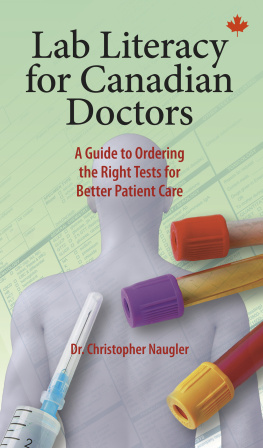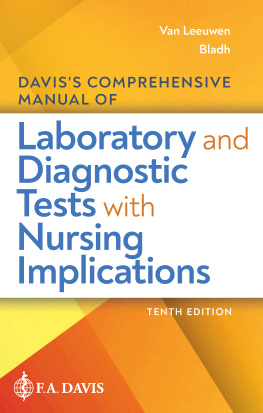DR. ETHAN FLYNN DR. CHRISTOPHER NAUGLER DR. LAUNNY FAULKNER DR. CHRISTOPHER NAUGLER DR. ETHAN FLYNN DR.
DAVINDER SIDHU DR. CHRISTOPHER NAUGLER DR. LAUNNY FAULKNER DR. LELAND B. BASKIN DR. CHRISTOPHER NAUGLER DR.
DAVINDER SIDHU DR. CHRISTOPHER NAUGLER DR. DAVINDER SIDHU DR. CHRISTOPHER NAUGLER DR. CHRISTOPHER NAUGLER AND DR. LELAND B.
Overall approach
The diagnosis of most ear, nose, and throat ailments, and respiratory ailments, comes from a careful history and physical examination. Most presentations do not require laboratory testing.
Disorders and clinical presentations
Asthma
Keys to workup Diagnosis is based on the presence of compatible signs and symptoms, family history, pulmonary function testing, and response to treatment. Lab investigations Routine investigations are not recommended. Pearls Asthmatic individuals may have an elevated IgE, but this test is not useful in establishing a diagnosis.
Serum allergy testing is generally not useful, either: it delivers results with high false-positive and false-negative rates.
Cough, acute
Keys to workup Findings from patient history and physical exam should guide decisions about testing. In the vast majority of cases, lab tests are not indicated. The exception is if you suspect a cough arises from another medical condition, such as heart disease. Base your decision about lab tests on their utility for diagnosing the suspected underlying disease. The key is to rule out life-threatening conditions (e.g., pneumonia, exacerbation of severe asthma or COPD, pulmonary embolus, heart failure).
Lab investigations Routine investigations are not recommended.
Otitis media, acute
Keys to workup Diagnosis is clinical, based on the presence of compatible signs and symptoms. Lab investigations Routine investigations are not recommended.
Rhinosinusitis
Keys to workup Diagnosis of acute bacterial rhinosinusitis is clinical, based on the presence of compatible signs and symptoms lasting more than 7 days. Lab investigations Routine investigations are not recommended. Pearls Routine nasal culture is not recommended.
If culture becomes necessary due to complications, obtain a specimen through maxillary tap or endoscopy.
Sore throat, acute
Keys to workup Diagnosis is clinical, based on the presence of compatible signs and symptoms. Clinical scoring systems stratify patient risk for group A streptococcal infection (e.g., Centor score, McIsaac score). In the McIsaac score, each of the following scores a point: temperature higher than 38C (100.4F) absence of cough tender anterior cervical adenopathy tonsillar swelling or exudate patient age between 3 and 14 years Subtract a point for patients aged 45 years or older. Lab investigations Throat culture Order this if a patient: has a score of 2 or 3; initiate treatment if the culture is positive has a score of 4; culture and initiate treatment simultaneously For patients with a score of 0 or 1, routine throat culture is generally not necessary. Rapid antigen test This test has the advantage of providing a rapid answer, and most commercial kits have sensitivities in the range of 90% and specificities in the range of 95%.
The rapid antigen test is offered by some labs and also as a point-of-care test for office uses. Pearls A negative rapid antigen test does not need follow-up with a throat culture or tests for inflammatory markers.
References
McIsaac WJ , White D , Tannenbaum D , et al . A clinical score to reduce unnecessary antibiotic use in patients with sore throat. CMAJ . 1998 ;():.
Medline:9475915
Further reading
Becker A , Lemire C , Brub D , et al . Asthma guidelines working group of the Canadian Network for Asthma Care: summary of recommendations from the Canadian Asthma Consensus guidelines, 2003. CMAJ . 2005 ;( suppl ): S3 . Medline:16157733 Desrosiers M , Evans GA , Keith PK , et al . Canadian clinical practice guidelines for acute and chronic rhinosinusitis.
Allergy Asthma Clin Immunol . 2011 ;():. http://dx.doi.org/10.1186/1710-1492-7-2 . Medline:21310056 Dicpinigaitis PV , Colice GL , Goolsby MJ , et al . Acute cough: a diagnostic and therapeutic challenge. 2009 ;():. http://dx.doi.org/10.1186/1745-9974-5-11 . http://dx.doi.org/10.1186/1745-9974-5-11 .
Medline:20015366 Pelucchi C , Grigoryan L , Galeone C , et al , and the ESCMID Sore Throat Guideline Group . Guideline for the management of acute sore throat. Clin Microbiol Infect . 2012 ;( suppl 1 ):. http://dx.doi.org/10.1111/j.1469-0691.2012.03766.x . Medline:22432746
Dermatology
DR.
ETHAN FLYNN Abbreviations ALC-1 antiliver cytosol antibody type 1 ALKM-1 antiliver kidney microsomal antibody type 1 ALP alkaline phosphatase ALT alanine aminotransferase AMA antimitochondrial antibodies ANA antinuclear antibody anti-TPO antithyroid peroxidase ASMA antismooth muscle antibody AST aspartate aminotransferase BUN blood urea nitrogen CBC complete blood count CRP C-reactive protein CSF cerebrospinal fluid DFA direct fluorescence assay DIC disseminated intravascular coagulation eGFR estimated glomerular filtration rate EIA enzyme immunoassay ELISA enzyme-linked immunosorbent assay ESR erythrocyte sedimentation rate FTA-ABS fluorescent treponemal antibody absorption test GGT -glutamyltransferase HSV herpes simplex virus ICE immune-capture EIA IFA immunofluorescent assay IgA immunoglobulin A IgG immunoglobulin G IgM immunoglobulin M KOH potassium hydroxide LCR ligase chain reaction MHA-TP microhemagglutination assayTreponema pallidum MRSA methicillin-resistant Staphylococcus aureus NAAT nucleic acid amplification testing PCR polymerase chain reaction PT/INR prothrombin time or international normalized ratio RPR rapid plasma reagin RT-PCR reverse transcription polymerase chain reaction SSSS staphylococcal scalded skin syndrome STD sexually transmitted disease T4 thyroxine TPPA Treponema pallidum particle agglutination TSH thyroid-stimulating hormone (thyrotropin) tTG tissue transglutaminase TTP thrombotic thrombocytopenic purpura VDRL Venereal Disease Research Laboratory test
Overall approach
Key steps in diagnosis
The correct algorithm for proper skin pathology diagnosis depends on: a thorough clinical history a complete physical exam (including mucous membranes) Before pursuing any laboratory tests, the clinician should determine whether a disorder is: primary (a disease arising from, and typically localized to, the skin): for these disorders, clinical laboratory tests typically have dubious utility a cutaneous manifestation of a systemic disease: when systemic disease is suspected or cannot be ruled out, laboratory testing of serum, plasma, or even urine is useful Diagnosis of primary skin disease may also require: tissue biopsy with histopathological evaluation Tzanck smear, in which the exfoliated squamous cells of an unroofed vesicle are evaluated microscopically for viral cytopathic morphologic changes Radiologic evaluation may occasionally be used, mostly in metastatic neoplastic or paraneoplastic etiologies of cutaneous disease.
Skin biopsy procedures









